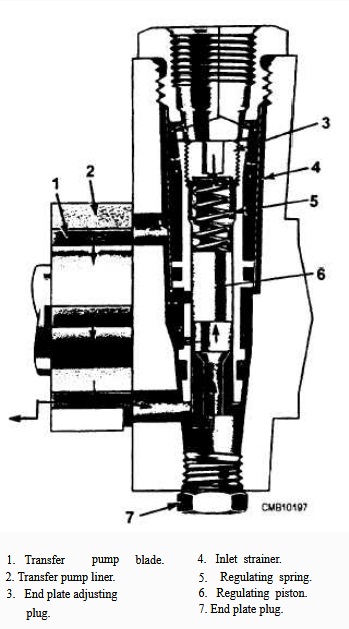two pumping plungers located in the pumping cylinder. Slots in the rear of the rotor provide a place for two spring-loaded transfer pump blades. In the rotor, the shoe, which provides a large bearing surface for the roller, is carried in guide slots. The rotor shaft rotates with a very close fit in the hydraulic head. A passage through the center of the rotor shaft connects the pumping cylinder with one charging port and one discharging port The hydraulic head in which the rotor turns has a number of charging and discharging port, based on the number of engine cylinders. An eight- cylinder engine will have eight charging and eight discharging ports. The governor weight retainer is supported on the forwarded end of the rotor.

Figure 5-14. - Transfer pump.
TRANSFER PUMP (fig. 5-14) - The transfer pump is a positive displacement, vane-style unit, consisting of a stationary liner with spring-loaded blades that ride in slots at the end of the rotor shaft. The delivery capacity of the transfer pump is capable of exceeding both pressure and volume requirements of the engine, with both varying in proportion to engine speed. A pressure regulator valve in the pump end plate controls fuel pressure. A large percentage of the fuel from the pump is bypassed through the regulating valve to the inlet side of the pump. The quantity and pressure of the fuel bypassed increases, as pump speed increases.
The operation of the model DB2 injection is similar to that of an ignition distributor. However, instead of the ignition rotor distributing high-voltage sparks to each cylinder in firing order, the DB2 pump distributes pressurized diesel fuel as two passages align during the rotation of the pump rotor, also in firing order. The basic fuel flow is as follows:
Fuel is drawn from the fuel tank by a fuel lift pump (mechanical or electrical) through the primary and secondary filters before entering the transfer pump.
As fuel enters the transfer pump, it passes through a cone-type filter and on into the hydraulic head assembly of the injection pump.
Fuel under pressure is also directed against a pressure regulator assembly, where it is bypassed back to the suction side should the pressure exceed that of the regulator spring.
Fuel under transfer pump pressure is also directed to and through a ball-check valve assembly and against an automatic advance piston.
Pressurized fuel is also routed from the hydraulic head to a vent passage leading to the governor linkage area, allowing any air and a small quantity of fuel to return to the fuel tank through a return line which self-bleeds air from the system. Fuel that passes into the governor linkage compartment is sufficient to fill it and lubricate the internal parts.
Fuel leaving the hydraulic head is directed to the metering valve, which is controlled by the operator throttle position and governor action. This valve controls the amount of fuel that will be allowed to flow on into the charging ring and ports.Continue Reading
